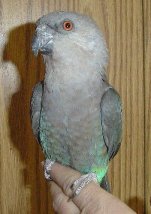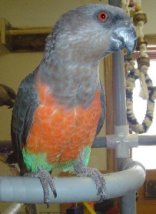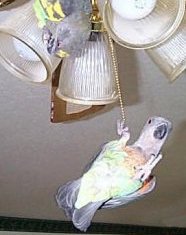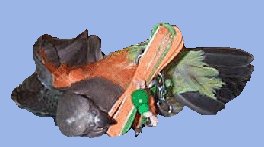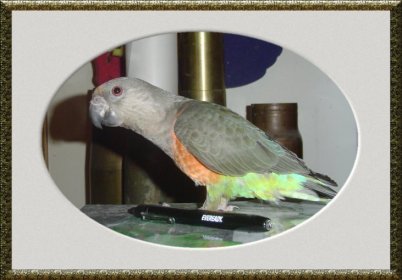The Red Bellied Parrot (Poicephalus rufiventris)

The Red Bellied parrot belongs to the same genus as the Senegal, Meyers, and BrownHead, (to name a few). It is an endearing, smaller sized parrot originating in Ethiopia, Tanzania and Somalia, Africa. The belief is that most of the Red Bellieds we see in aviculture today originated from Tanzania.
This parrot is considered to be about a 9” parrot, but this can be deceiving as they are a short tailed parrot, making a good portion of the 9 inches, body. Typical weight of a Red Bellied would be 140 grams, with some going up to 170 grams and others being more dainty at 130 grams. On the whole, they are a chunky, sturdy looking little bird.
The Red Bellied parrot is the most sexually dimorphic in the genus. This means you can easily visually discern the sexes, although it is not reliable to do so with babies. Adult plumage of the cock bird will have a beautiful orange to red chest area while the hen will be more green and grey with maybe a hint of orange wash. As babies, the plumage can resemble either sex, depending on the individual pairs of birds.
The Red Bellied parrot, regardless of sex, has very red eyes. Some people find this eerie at first, but once you are used to it, it is very striking. Due to the bright red, it is very easy to see the dilating of the pupils when they flash at you.
Red Bellieds are relatively quiet birds (comparatively speaking), making them quite acceptable to apartment living. They do have a little screech which some may find offensive, but it’s not a sound that is often repeated ad nauseam. I generally look at the screech as a screech of joy.
Red Bellieds can be quite good talkers. They do not compare for voice quality with the likes of African Greys, but in their own voice, which this writer says is a cross between a computer voice and Donald Duck on helium, they can have quite an extensive vocabulary. A lot of the older information on Red Bellieds will say that the hens don’t speak, but this is untrue. The hens can speak as well as the males.
Red Bellieds are quite interesting players. It takes little to be considered a toy to them. For that matter, I’m not sure they can’t make a toy out of their own feet. It is not unusual to see young Red Bellieds playing on their backs in the bottom of the cage with nothing. They really are quite clownish. They also love hanging, preferably upside down by one toe, be it from a perch, a swing, your curtains, curtain sash, door frame, anything that allows a little grip. I should also mention, they generally aren’t a type of bird that quits when strangers are near by. If they were playing, they will continue playing, if they were talking, they will continue talking. Since they are good at playing and amusing themselves, they are often considered good home alone birds……they don’t necessarily need company, and they don’t seem to mind their owner being gone working. A larger cage per their size is often required to give them enough room to move and attack their toys.
Red Bellieds, like so many of the poicephalus, CAN have attitudes. This could mean an inability to get along with other birds. Size means little to them, making them just as likely to terrorize a bird bigger as one smaller then themselves. Caution is always required when allowing interaction with any birds (always, not just in the case of poicephalus) They can end up choosing a favorite person to the exclusion of all others. The key for prevention of this is socialization/socialization/socialization. The larger the world of the bird is, the more well rounded they become. The more interaction with different people and different birds, the less chance of them becoming overprotective of their person. Most Red Bellieds love getting cuddles and being petted and enjoy sitting on your shoulder or leg.
It does appear that the Red Bellieds might be a little more prone to panics or phobic spells than some other birds. When dealing with Red Bellieds it is always important to remember this, and to make sure you don’t inadvertently contribute to it. One thing to avoid with Red Bellieds is a chase scenario. Often a bird will flutter away from something (pseudo panic) and the owner will rush over to recover and comfort the bird. The bird does not view it in that light, rather, they see it (in their panic) as a big predator coming to get them. You then become part of the fear and you will often hear of a Red Bellied being scared, even terrified, of their person after this. In a case like the above, best thing to do is let the bird calm down, and then call the bird over to you. Don’t advance until you can tell the fear has left the bird.
I believe that Red Bellieds are wonderful pets. They are entertaining, they are cuddly, they can be talkative, they can be independent and they are relatively quiet. They will constantly amuse and amaze you. While my personal belief is that the females make slightly better pets, either sex is wonderful.

This site needs an editor - click to learn more!
You Should Also Read:
more Bird Profiles
Bird Site Map
Red Bellied Parrots Jigsaw Puzzle
Related Articles
Editor's Picks Articles
Top Ten Articles
Previous Features
Site Map
Content copyright © 2023 by Gay Noeth. All rights reserved.
This content was written by Gay Noeth. If you wish to use this content in any manner, you need written permission. Contact
BellaOnline Administration
for details.


